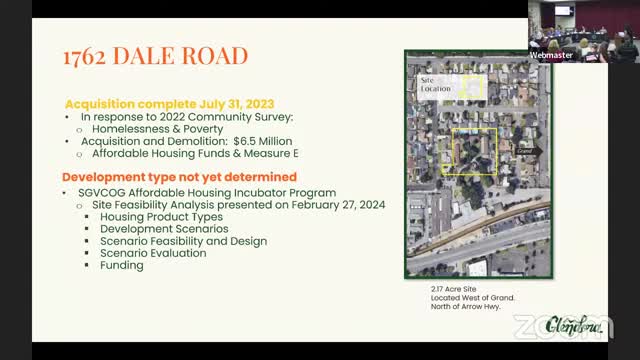City Council explores innovative solutions for affordable housing crisis
August 27, 2024 | Glendora, Los Angeles County, California
This article was created by AI summarizing key points discussed. AI makes mistakes, so for full details and context, please refer to the video of the full meeting. Please report any errors so we can fix them. Report an error »

In a recent city council meeting, officials discussed critical housing strategies aimed at addressing the diverse needs of the community, particularly for low-income and special needs populations. The meeting focused on the results of a feasibility study conducted by the regional housing trust, which explored various development options for affordable housing.
The council outlined three primary options for the site in question. The first option proposes the development of permanent affordable housing exclusively, targeting families with incomes up to 80% of the area’s median income. This model would allow for approximately 79 units, utilizing a density bonus that permits 36 dwelling units per acre.
The second option suggests a hybrid approach, dividing the site to include both transitional housing and permanent affordable housing. This would allocate half an acre for transitional housing, potentially accommodating between 28 and 50 beds, while the remaining land would support up to 60 units of permanent housing. This model aims to provide temporary shelter for individuals in need, with supportive services to facilitate their transition to permanent housing.
The third option further reduces the transitional housing footprint to a quarter acre, allowing for 25 beds, while maximizing the area for permanent housing, which could yield up to 69 units. Each of these options comes with varying estimated costs, with the city expected to contribute land and potentially cover operational expenses ranging from $900,000 to $2 million annually, depending on the chosen model.
Council members emphasized the importance of these housing initiatives as a means to prevent homelessness and provide stability for vulnerable populations. They acknowledged that while no single solution would eradicate homelessness, these developments could significantly alleviate the issue by offering permanent housing solutions and transitional support.
The council is set to deliberate further on these options, weighing the financial implications and community needs as they move forward with their housing strategy.
The council outlined three primary options for the site in question. The first option proposes the development of permanent affordable housing exclusively, targeting families with incomes up to 80% of the area’s median income. This model would allow for approximately 79 units, utilizing a density bonus that permits 36 dwelling units per acre.
The second option suggests a hybrid approach, dividing the site to include both transitional housing and permanent affordable housing. This would allocate half an acre for transitional housing, potentially accommodating between 28 and 50 beds, while the remaining land would support up to 60 units of permanent housing. This model aims to provide temporary shelter for individuals in need, with supportive services to facilitate their transition to permanent housing.
The third option further reduces the transitional housing footprint to a quarter acre, allowing for 25 beds, while maximizing the area for permanent housing, which could yield up to 69 units. Each of these options comes with varying estimated costs, with the city expected to contribute land and potentially cover operational expenses ranging from $900,000 to $2 million annually, depending on the chosen model.
Council members emphasized the importance of these housing initiatives as a means to prevent homelessness and provide stability for vulnerable populations. They acknowledged that while no single solution would eradicate homelessness, these developments could significantly alleviate the issue by offering permanent housing solutions and transitional support.
The council is set to deliberate further on these options, weighing the financial implications and community needs as they move forward with their housing strategy.
View full meeting
This article is based on a recent meeting—watch the full video and explore the complete transcript for deeper insights into the discussion.
View full meeting
